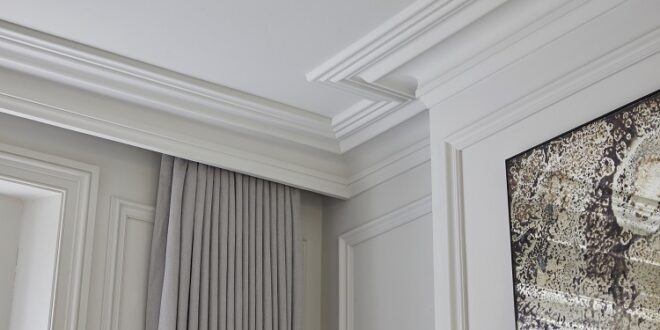The elegance and meticulous attention to detail of Edwardian architecture have had a lasting impression on the field of design. The Edwardian cornice is one characteristic that perfectly captures the grandeur of this period.
These decorative moldings greatly enhance a space’s overall aesthetic appeal in addition to their practical use. Selecting the appropriate Edwardian cornice is essential for a design to be harmonious and classic.
This article will explore ten essential tips to guide you in selecting the perfect Edwardian cornice for your space.
1. Historical Authenticity
The importance of authenticity cannot be overstated when choosing an Edwardian cornice. Authenticity guarantees that the selected cornice blends well with the Edwardian architectural style.
It will be helpful to investigate the historical background of Edwardian design, taking into account the common motifs, materials, and craftsmanship. To learn the subtleties of genuine Edwardian cornices, consult reliable literature, architectural plans, and archive photos.
This preparatory work guarantees that the chosen option honors the era’s fundamental design ideas while complementing the period.
2. Architectural Harmony
Integrating the Edwardian cornice with the space’s intended or existing architectural elements in a cohesive manner is necessary to achieve architectural harmony. Take into account the room’s general design language, scale, and proportion.
Rather than competing with or overwhelming the architectural characteristics, the cornice should accentuate them. To choose the right cornice size, measure the room’s length and ceiling height. The essence of Edwardian elegance is captured in a visually harmonious and balanced area enhanced by a well-proportioned cornice.
3. Material Selection
Edwardian cornices were made of a variety of materials, each of which added something special to the overall design. Metal, wood, and plaster are typical materials. Plaster cornices, which were common in Edwardian architecture, are ideal for genuine design replication since they permit fine detailing.
Wood gives an air of refinement with its cozy, organic appeal. Metal cornices give Edwardian design a decidedly contemporary spin; they frequently have elaborate patterns. Carefully consider the material that best suits your design goals, maintenance requirements, and financial constraints.
4. Ornamental Details
The elaborate decoration on Edwardian cornices is one of their distinguishing features. The degree of complexity can vary from delicate motifs to intricate patterns, like dentil molding, floral patterns, and egg-and-dart motifs.
Make sure the ornamental features on an Edwardian cornice match the room’s general design scheme when making your selection. The aim is to balance the intricate details and the classic simplicity of Edwardian design.
Make an informed choice about the ornamental features of the cornice by taking into account the intended level of luxury as well as the purpose of the room.
5. Customization Options
Choosing a personalized Edwardian cornice lets you add a touch of individuality that is exactly in line with your design concept. Collaborate with proficient craftspeople or organizations specializing in architectural moldings to craft a custom cornice that meets your requirements.
Options for customization include picking particular motifs, modifying the size, and picking materials based on your tastes. Even while this alternative could cost more, the outcome is a cornice that is one-of-a-kind and elevates the aesthetics of your room.
6. Budget Considerations
Selecting the appropriate Edwardian cornice requires careful consideration of both financial limits and design goals. Analyze the project’s available budget and look at possibilities that make sense financially.
There are substitutes that mimic the Edwardian style without sacrificing quality, even though genuine materials and elaborate workmanship can raise the price. To guarantee a great result, prioritize important components such as material authenticity and ornamental features based on your budget.
7. Maintenance and Durability
The material and amount of upkeep needed for an Edwardian cornice determine how long it will last. Think about how to keep the cornice in good working order over time. While wood and metal may require particular cleaning and preservation techniques, plaster may only need routine inspections and repairs.
Select a material based on your level of willingness and maintenance ability. Inquire about manufacturer warranties and guarantees to ensure the chosen cornice will last a long time.
8. Lighting Considerations
Lighting plays a significant role in determining the level of elegance that can be achieved with an Edwardian cornice. It is important to carefully consider the placement of the lighting fixtures to establish an aesthetically pleasant environment and draw attention to the decorative features.
Experiment with different lighting angles to see if you can bring out the texture of the cornice and the shadows it casts. The adequate lighting draws attention to the cornice and contributes to the room’s overall mood, drawing attention to the Edwardian architecture.
9. Installation Expertise
During the construction of an Edwardian cornice, a skilled hand is required to ensure that the finished product is accurate and long-lasting. Search for skilled laborers or consultants with previous expertise in installing architectural moldings.
The end product of a successful installation should have a smooth and polished appearance. Ask the installer whether they have any experience working with Edwardian design components. Also, request to view references or portfolios of their previous work if they are going to be doing the installation.
A cornice that has been expertly installed ensures that it will be the focus of attention, which contributes to an improved aesthetic across the space.
10. Environmental Considerations:
Environmental sustainability is a major factor in design decisions in the modern day. Investigate eco-friendly production methods and materials while choosing an Edwardian cornice.
Seek alternatives that make use of sustainable or recycled materials, and find out the manufacturer’s eco-friendly policies. Making environmentally friendly decisions is consistent with ethical care of architectural history as well as global sustainability initiatives.
Choose the Right Edwardian Cornice
Several factors need to be carefully considered while choosing the perfect Edwardian cornice, such as historical accuracy, design harmony, material concerns, and practical considerations.
When used correctly, an Edwardian cornice may be the finishing touch that turns a room into a monument to timeless design elegance. This holds whether innovative innovations were chosen or historical designs were replicated to transform the space.
 HammBurg Be informed with latest news, reviews, entertainment, lifestyle tips, and much more.
HammBurg Be informed with latest news, reviews, entertainment, lifestyle tips, and much more.




